The Woman in Black
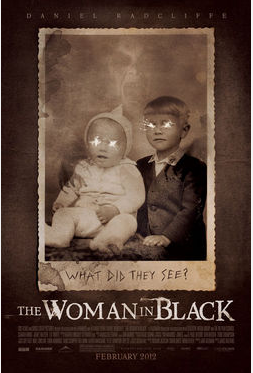
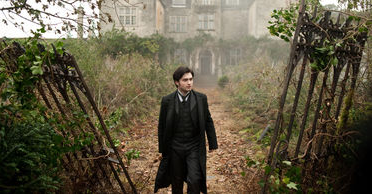 The film is loosely based on the 1983 novel by Susan Hill, and by loosely, I mean that screenwriter Jane Goldman (X-Men: First Class) has basically taken the basic premise and lead characters, and then pretty much has gone in her own direction. The story has been adapted many times in the past, most notably a stage play that's been running in London for years, and a British made-for-TV movie from the late 80s. Since both of those are more faithful adaptations of Hill's story, it makes sense for Goldman to go her own direction. A few of the book's major sequences have made it in the film, but some of the more famous scenes (such as the one set at a funeral, where the Woman in Black initially makes her first appearance) are oddly missing from this adaptation. Still, I had no problem seeing this movie as a separate entity from the source material. It stands strong on its own, and works well enough, thanks to the atmospheric direction by James Watkins.
The film is loosely based on the 1983 novel by Susan Hill, and by loosely, I mean that screenwriter Jane Goldman (X-Men: First Class) has basically taken the basic premise and lead characters, and then pretty much has gone in her own direction. The story has been adapted many times in the past, most notably a stage play that's been running in London for years, and a British made-for-TV movie from the late 80s. Since both of those are more faithful adaptations of Hill's story, it makes sense for Goldman to go her own direction. A few of the book's major sequences have made it in the film, but some of the more famous scenes (such as the one set at a funeral, where the Woman in Black initially makes her first appearance) are oddly missing from this adaptation. Still, I had no problem seeing this movie as a separate entity from the source material. It stands strong on its own, and works well enough, thanks to the atmospheric direction by James Watkins.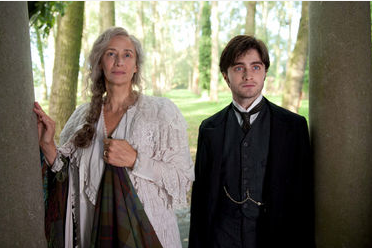 The story is set in England in an unspecified time, but it appears to be the late 1800s or early 1900s. Arthur Kipps (Daniel Radcliffe) is a broken down and sad-faced London solicitor whose career has pretty much been in shambles ever since his wife died in childbirth. Since then, he's struggled unsuccessfully to move on, while also trying to raise his now four-year-old son. The boss at his firm decides to give him one last chance to save his career - Arthur must travel to the small and out of the way town of Crythin Gifford, where he is to locate the secluded manor known as Eel Marsh House, and settle the affairs and paperwork of it deceased former owner, Alice Drablow. When Arthur arrives in the tiny village, he finds that the locals are not welcoming. They seem suspicious, and guard their children fiercely, some even locking their children away in secret rooms in their basements for safety. The only local who is friendly toward Arthur is a wealthy man named Sam Daily (Ciaran Hinds), who has suffered the loss of his own child, but refuses to believe in the supernatural talk of a curse that seems to plague the local village, and is killing the local children.
The story is set in England in an unspecified time, but it appears to be the late 1800s or early 1900s. Arthur Kipps (Daniel Radcliffe) is a broken down and sad-faced London solicitor whose career has pretty much been in shambles ever since his wife died in childbirth. Since then, he's struggled unsuccessfully to move on, while also trying to raise his now four-year-old son. The boss at his firm decides to give him one last chance to save his career - Arthur must travel to the small and out of the way town of Crythin Gifford, where he is to locate the secluded manor known as Eel Marsh House, and settle the affairs and paperwork of it deceased former owner, Alice Drablow. When Arthur arrives in the tiny village, he finds that the locals are not welcoming. They seem suspicious, and guard their children fiercely, some even locking their children away in secret rooms in their basements for safety. The only local who is friendly toward Arthur is a wealthy man named Sam Daily (Ciaran Hinds), who has suffered the loss of his own child, but refuses to believe in the supernatural talk of a curse that seems to plague the local village, and is killing the local children.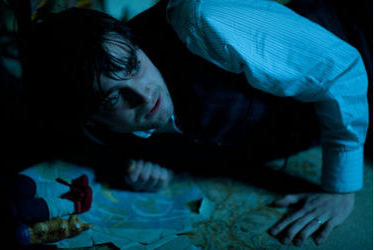 We witness this curse in the film's opening scene, when three little girls are having a tea party, then suddenly get up and walk to the window, as if in a trance, throwing themselves to their deaths. The locals believe that an evil spirit dressed entirely in black is responsible, and that the cursed specter originates from secluded Eel Marsh House. Hence, when Arthur tries to ask questions about what happened in the house or to Mrs. Drablow, no one is very forthcoming with the answers. Regardless, Arthur needs to complete this task if he wants to hold onto his job, so he travels to the House alone, with plans to stay there until he is finished with his work. Even if Eel Marsh House didn't have a dark and mysterious history, just looking at the outside of the place would be enough to convince me it was haunted.
We witness this curse in the film's opening scene, when three little girls are having a tea party, then suddenly get up and walk to the window, as if in a trance, throwing themselves to their deaths. The locals believe that an evil spirit dressed entirely in black is responsible, and that the cursed specter originates from secluded Eel Marsh House. Hence, when Arthur tries to ask questions about what happened in the house or to Mrs. Drablow, no one is very forthcoming with the answers. Regardless, Arthur needs to complete this task if he wants to hold onto his job, so he travels to the House alone, with plans to stay there until he is finished with his work. Even if Eel Marsh House didn't have a dark and mysterious history, just looking at the outside of the place would be enough to convince me it was haunted. 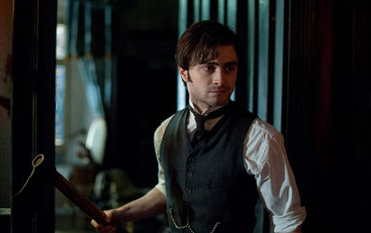 The Woman in Black is a movie that builds quiet, eerie dread in its audience. Sometimes it's able to create an effective atmosphere out of very little, such as the scene where Arthur is exploring a room in the mansion, and we are watching him through the reflection of the eyes of the many antique toys that fill the room, so it looks like the inanimate objects are following him with their eyes. There is also a very effective 10 or 15 minute sequence where Arthur runs from room to room, chasing shadows, or following eerie sounds, many of which seem to come from a room on the second floor that is locked. (Of course, we know that room won't stay locked for long.) The dialogue is minimalist here, letting the foreboding quiet of the mansion, and the eerie sounds within provide much of the film's soundtrack. I've heard some people complain that this makes the movie slow, or the story sluggish, but I couldn't disagree more. I loved it how this movie was confident enough in itself to create a genuine slow burning sense of dread and isolation, and then pay off with some surprisingly effective scares.
The Woman in Black is a movie that builds quiet, eerie dread in its audience. Sometimes it's able to create an effective atmosphere out of very little, such as the scene where Arthur is exploring a room in the mansion, and we are watching him through the reflection of the eyes of the many antique toys that fill the room, so it looks like the inanimate objects are following him with their eyes. There is also a very effective 10 or 15 minute sequence where Arthur runs from room to room, chasing shadows, or following eerie sounds, many of which seem to come from a room on the second floor that is locked. (Of course, we know that room won't stay locked for long.) The dialogue is minimalist here, letting the foreboding quiet of the mansion, and the eerie sounds within provide much of the film's soundtrack. I've heard some people complain that this makes the movie slow, or the story sluggish, but I couldn't disagree more. I loved it how this movie was confident enough in itself to create a genuine slow burning sense of dread and isolation, and then pay off with some surprisingly effective scares.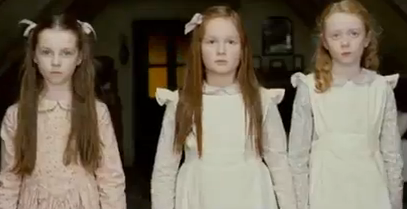 As a ghost story, this is as straight-forward as you can get. There is no doubt that Eel Marsh House is haunted, and that some evil spirit is haunting the nearby village and killing off the children in bizarre "accidents" or suicides. The movie doesn't try to convince us that Arthur is possibly imagining the things he witnesses within the house. And as he digs through the paperwork left behind by its former resident, and we learn the tragic history of the house, there's even less doubt than before. I admired that the filmmakers were able to fully embrace the story's traditional haunted house roots without the slightest bit of irony. The movie goes all out with the creeping atmosphere and images, and winds up raising more uneasy feelings from the audience, than it would have with flashy cuts and special effects. There are a couple "boo!" jump scare moments, which kind of had me worried this movie was going to throw away its promise on cheap jolts, but fortunately, the movie settles down to an appropriate slow-burning sense of dread quickly enough.
As a ghost story, this is as straight-forward as you can get. There is no doubt that Eel Marsh House is haunted, and that some evil spirit is haunting the nearby village and killing off the children in bizarre "accidents" or suicides. The movie doesn't try to convince us that Arthur is possibly imagining the things he witnesses within the house. And as he digs through the paperwork left behind by its former resident, and we learn the tragic history of the house, there's even less doubt than before. I admired that the filmmakers were able to fully embrace the story's traditional haunted house roots without the slightest bit of irony. The movie goes all out with the creeping atmosphere and images, and winds up raising more uneasy feelings from the audience, than it would have with flashy cuts and special effects. There are a couple "boo!" jump scare moments, which kind of had me worried this movie was going to throw away its promise on cheap jolts, but fortunately, the movie settles down to an appropriate slow-burning sense of dread quickly enough.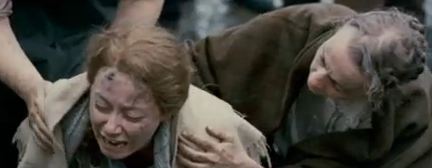 And what of Daniel Radcliffe, in his first big screen starring role since the Harry Potter films finished? I found him very effective in a largely minimalist role. His Arthur Kipps is not really supposed to be a dynamic hero to begin with. He's a depressed man, haunted by the memory of his wife, and not really sure how to raise a child on his own. His tragic past not only makes him sympathetic, but also susceptible to the ghostly happenings around him. I've read other reviews complaining that he is not believable, or too young to play the role. Once again, I have to disagree. He carries himself well here. I have also seen him perform twice on the Broadway stage in very different roles, so I know he is a capable actor who is willing to take risks. This may be a somewhat safe role, as it's not particularly deep and driven almost entirely by the plot, but it's an interesting one nonetheless.
And what of Daniel Radcliffe, in his first big screen starring role since the Harry Potter films finished? I found him very effective in a largely minimalist role. His Arthur Kipps is not really supposed to be a dynamic hero to begin with. He's a depressed man, haunted by the memory of his wife, and not really sure how to raise a child on his own. His tragic past not only makes him sympathetic, but also susceptible to the ghostly happenings around him. I've read other reviews complaining that he is not believable, or too young to play the role. Once again, I have to disagree. He carries himself well here. I have also seen him perform twice on the Broadway stage in very different roles, so I know he is a capable actor who is willing to take risks. This may be a somewhat safe role, as it's not particularly deep and driven almost entirely by the plot, but it's an interesting one nonetheless.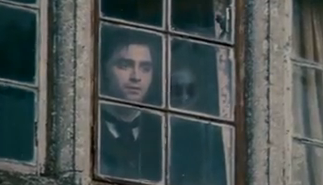
See the movie times in your area or buy the DVD at Amazon.com!






0 Comments:
Post a Comment
<< Home